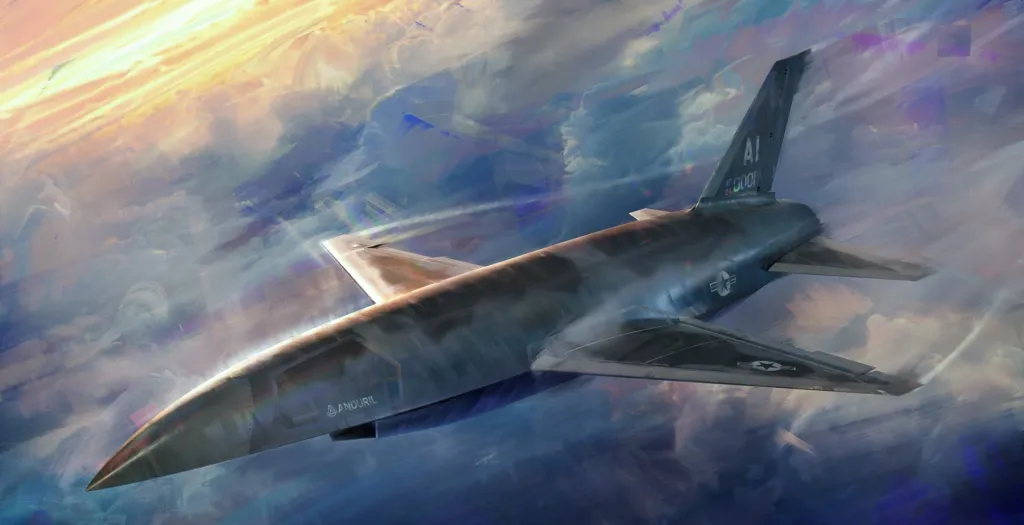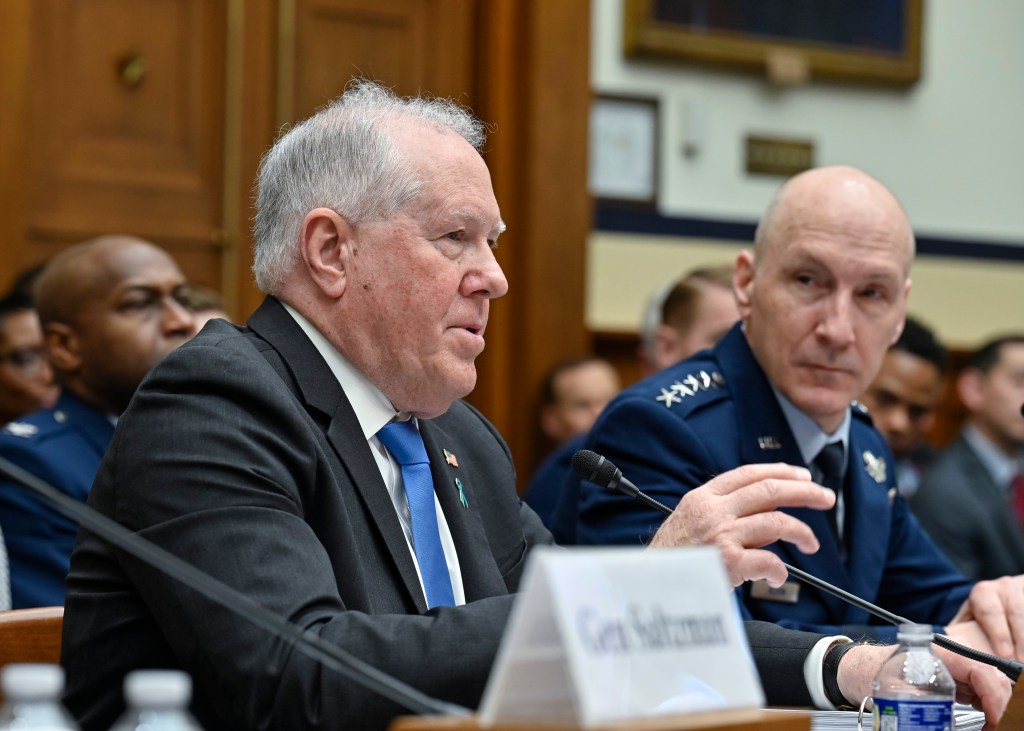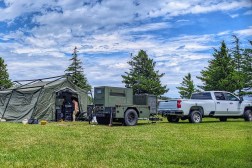Air Force likely weighing several factors as it contemplates future of NGAD

Comments recently made by top Air Force leaders have suggested the service is having second thoughts on its approach to acquiring a new stealth fighter — a platform known as the Next-Generation Air Dominance (NGAD) aircraft.
Officials have cited advancements in technologies and budget uncertainty as reasons for reexamining the platform, which was expected to be the centerpiece of a networked family of systems. And while analysts who spoke with DefenseScoop agreed that both issues will influence NGAD’s fate, they also noted a number of different variables are likely shaping the Air Force’s considerations.
“Those decisions don’t get made in a vacuum. They have analyses and other things that underpin their investment decisions,” said Travis Masters, director of the Government Accountability Office’s contracting and national security acquisitions team and lead for the watchdog’s work on the NGAD program.
New missions, new technologies
The NGAD aircraft is envisioned as a long-range crewed fighter jet equipped with advanced sensors and weapons payloads designed to operate in highly contested environments in the Indo-Pacific, where China is seen as the top military threat to U.S. forces. Considered a replacement for the fifth-generation F-22 Raptor, NGAD’s main mission will be to establish air superiority.
Fielding a new air-superiority fighter for future operations is paramount, said Michael Bohnert, engineer and analyst at the RAND Corp. The Lockheed Martin-made F-22 has been in service for two decades, and the Air Force has requested to retire older Raptors — of which there are only 186 in operation — in its last few annual budget requests to Congress.
“There needs to be a replacement for the F-22, and the [F-35 Lightning] is not it,” Bohnert said in an interview. “The F-35 is a strike fighter, the F-22 is an air-superiority fighter. That is something you need to counter adversary bombers, heavier fighters, etc. It’s a mission set that you need something more like the follow-on to an F-22 to do.”
Although NGAD is a highly classified program, it’s thought that the platform will have improved stealth, significantly longer ranges and larger weapons, according to Mark Gunzinger, director of future aerospace concepts and capabilities assessments at the Mitchell Institute.
He emphasized that no weapon system currently in the United States’ inventory would be able to effectively establish air dominance in the region.
“Not only would NGAD’s cancellation risk putting our air superiority forces further behind China, it would have a major impact on all U.S. military operations in the future,” Gunzinger wrote in an email to DefenseScoop.
Until recently, NGAD was thought to be on schedule to be fielded sometime in the 2030s. The Air Force announced last year that it intended to pick a prime contractor for the aircraft in 2024, with Lockheed Martin and Boeing widely considered to be the two main vendors vying for the program.
However, on June 13 Air Force Chief of Staff Gen. David Allvin hinted the service might be reevaluating plans due to funding constraints. He later told reporters during a June 14 briefing that “deliberations are still underway” and that the department is “looking at a lot of very difficult options that we have to consider.”
The Air Force initially began NGAD concept studies with the Defense Advanced Research Projects Agency in 2014, later expanding its scope to include an entire family of systems comprising loyal wingman drones known as collaborative combat aircraft (CCA) and advanced command-and-control technologies.
In the last decade of research and development, it’s possible that emerging threats have forced the Air Force to reconsider some of its original requirements and take a brief hiatus before moving further into the acquisition phase, J.J. Gertler, senior associate at the Center for Strategic and International Studies’ Aerospace Security Project, said in an interview.
Now, the service may be considering a larger NGAD airframe, Gertler said, noting that a platform the size of a bomber may not be effective in a traditional dogfight, but would still dominate enemy air spaces.
“Because you have a larger platform, you have a lot more range. It can go places and do things that a fighter couldn’t do,” he said. “That is where I’m guessing the current gap is. They started designing a fighter, and what they realized is they really need something more than that.”

Another factor likely influencing the Air Force’s deliberations are rapid advancements in unmanned technologies, especially its CCA efforts.
“What we are discovering, through leaning into our collaborative combat aircraft, is we’re not only looking at different ways to optimize human-machine teaming, but it’s also a different way of developing capabilities,” Allvin said during the June 14 media briefing.
Bohnert said it might be easy to integrate avionics and munitions onto unmanned platforms to accomplish some of those missions, but eventually the Air Force will need larger drones to accommodate additional size, weight and power requirements.
The extra mass provided by CCAs specifically developed for high-end fights will also help the Air Force in establishing air superiority, reducing any capability gap caused by a lack of operational F-22s, Gunzinger said. But because the drones are being designed to synergize with the Air Force’s sixth- and fifth-generation aircraft, he cautioned that “budget-driven actions like not acquiring sufficient [fifth-generation] F-35s and delaying the NGAD risk cutting the legs out from under the case for CCA.”
Budget woes
In an interview with Aviation Week published June 14, Secretary of the Air Force Frank Kendall echoed Allvin’s comments regarding the uncertain future of NGAD, noting the department is examining “lots of new things” it hadn’t considered in years prior as it builds its budget request for fiscal 2026.
The service certainly has no shortage of budget-related concerns. Not only has the Fiscal Responsibility Act impacted the entire Defense Department’s budget, the Air Force is also developing other costly programs — including the B-21 Raider stealth bomber and the Sentinel intercontinental ballistic missile.
The situation is not unlike the Navy’s, which is experiencing financial constraints related to readiness of its current ships and delays on multiple new vessels. The service chose to drastically reduce spending on its sixth-generation fighter program — the F/A-XX — in its budget request for fiscal 2025 to focus on near-term aircraft readiness.
The Air Force requested $2.7 billion for the NGAD platform in its FY ’25 budget request, indicating that it planned to spend $19.6 billion on the aircraft over the next five years. Officials have previously estimated that jet would cost around $300 million per unit.
Gunzinger noted that lawmakers may overlook Kendall and Allvin’s comments as a mechanism to signal it needs more funding for NGAD, an assumption he disagreed with.
“Because of this chronic underfunding, the Air Force must now modernize almost every element of its aging forces, including the two legs of the nuclear triad it is responsible for — the ICBM force and nuclear-capable bombers. After funding nuclear modernization, there is little budget left for other modernization programs,” he explained.
As the Air Force creates its budget plans for FY ’26, it’s likely reckoning with several unknown factors along with financial constraints that could impact whether or not the service decides to cut funds from NGAD, Gertler noted.
First, lawmakers from the Senate Armed Services Committee are considering a special fund for the Sentinel ICBM in its version of the 2025 National Defense Authorization Act, which could remove some or all of the burden of developing the $96 billion program from the Air Force. It was revealed in January that the effort will cost 37 percent more than originally expected, triggering a Nunn-McCurdy breach and subsequent review process.
Gertler also noted that the upcoming 2024 election and the possibility of a new administration or members of Congress with different priorities, is likely influencing the Air Force’s decision-making process.
“Right now, the Air Force is doing what it can with what it knows,” he said. “What it seems to know is that they need to change the NGAD aircraft from what they thought it was going to be.”
In addition, the service has a portfolio of other fighter jets needing upgrades and sustainment dollars. GAO’s Masters told DefenseScoop that having a “portfolio-level conversation” that includes all Air Force programs is critical when weighing tradeoffs and risks in a budget-constrained environment.
A 2022 report from the government watchdog recommended the Pentagon conduct an integrated acquisition portfolio review of all its manned fixed-wing fighter aircraft across both the Air Force and Navy that would analyze several programmatic elements. Since publication, the department has completed the review, which was given to the armed services committees in the House and Senate in February.
“Hopefully, that analysis should also be informing some of the decisions you’re hearing them talk about with regard to NGAD,” Masters said.

One option the Air Force could pursue moving forward would be to field a sixth-generation aircraft that the service can iterate on, adding new technologies and refreshing other capabilities while continuously learning from previous increments. The modular development approach is being used on a number of other Air Force efforts, particularly CCAs.
Allvin’s comments to reporters seemed to suggest that lessons it’s learning from CCA development are feeding into the Air Force’s other programs like NGAD, although he acknowledged that process isn’t a silver bullet for new systems.
“It’s the systems that make the difference,” he said. “So privileging design rather than very expensive hardware that is so expensive you can’t afford enough of them to be able to use, I think is one of the areas that we’re pursuing in several of the capabilities we’re developing.”
Masters noted there is value in taking an iterative approach, as it increases the likelihood that systems can be delivered on time and within budget with the capabilities warfighters need in the near term.
And while costly programs will be expensive no matter what, the method could mitigate some cost growth caused by unexpected problems after platforms are fielded, he added.
“If you take an incremental or iterative approach — which means that after that first increment or that first iteration you have more certainty about what you’re pursuing — you can then more likely come in on your actual cost or closer to your actual cost and schedule numbers,” Masters said.
Another possibility involves the Air Force fielding an aircraft it knows is not exactly what it envisions as the final platform, while keeping Congress and all relevant stakeholders in the loop, Bohnert said. The service could deliver some aircraft quickly, then learn from its mistakes and follow up with a successor variant — similar to how the service fielded the F-15 Eagle during the Cold War.
“I think that actually should be a perfectly acceptable strategy of putting out something that’s mediocre, learning from it, and whatever has the B or the C [variant] is fine,” Bohnert said. However, “I’m not sure in today’s budget and red-tape environment that could fly,” he added.
If the Air Force’s reasoning for reexamining NGAD leans more towards budget constraints than a change in the threat environment, however, that might prompt lawmakers to perceive the aircraft as a “failed program” and allocate those funds elsewhere, Gertler said.
“If members understand why they’re doing it and that there is a defined future to the program, they’re generally a lot more willing to go along than if the Air Force is saying, ‘Well, we just want to take a break for a while and we’re not sure what comes next,’” he explained. “It’s a more thoughtful process than a lot of folks seem to be giving credit to, but it doesn’t appear to be budget driven — rather threat driven.”
Mark Pomerleau contributed reporting.






